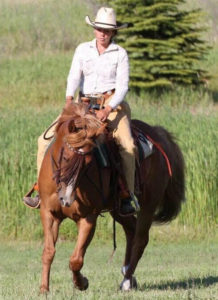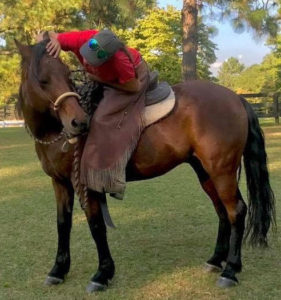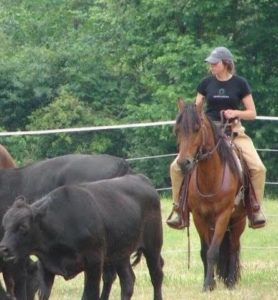
No longer a panicky mare
Editor’s Note: Amy Skinner is a regular guest columnist and has been a horse gal since age six. She works with owner/operator Jim Thomas as a trainer at Bar T Horsemanship where she rides and teaches English and Western. She also maintains Essence Horsemanship. Skinner has studied at the Royal Andalusian School of Equestrian Art in Spain, with Buck Brannaman, Leslie Desmond, Brent Graef, and many others.
In this post, we’re reminded that good trainers often learn as much they teach.
Read this related post from trainer Katrin Silva.
Amy Skinner writes:
Over the past few years, I have had the good fortune to run across some pretty upset horses. They’ve displayed behavior that ranged from rank to shut down, scared to just sometimes flat-out confusing:
- A 10 year old mustang who kicked violently at everything and bucked until he fell down, rested, and bucked some more.
- A mare who panicked when saddled and would flip over if she had to hold still.
- A little Morgan gelding who bolted and bucked for miles.

Once troubled, now calm and relaxed
The list goes on. These horses stick in my mind as ones who defied my training methods and made me scratch my head. I used steps I know and saw them not improve. What I learned is that sometimes methods provide a nice guideline. Other times, you need throw out the guidelines and experiment in the best interest of the horse.
The 10 year old mustang bolted constantly when I handled him on the ground. If you stared at him sideways or picked your nose, he was gone. You couldn’t force him in any way because he’d either bolt or go through a fence, and he had been pretty beat up from busting out of our round pen. Not jumping, just going straight through like the Kool Aid Man.
I couldn’t outmuscle him and really didn’t think that’d teach him anything except to try harder and use more of his muscle. So when he bolted, I caught him and started over like nothing had happened. Two things came of that – he stopped bolting after some weeks and he became wonderful to catch. The horse who was impossible to handle and catch is now my easiest.

Cow work helps Skinner’s process
As a young horse, that panicked mare had been snubbed up short to be saddled and reacted by flipping over. Now, when she saw a pad or saddle, her eyes rolled back and she raised her head in absolute fear. Keeping her still and repeatedly throwing a pad over did not produce better results. She became a stock still horse with tension from head to tail. If I mounted at this point, she would have certainly flipped over. I wasted a lot of time trying to put a saddle on her until she relaxed, and since she never offered to move, I didn’t think much of it. One day I decided to just longe her in a small circle while throwing a pad over her. She started out tight and scooted once the pad hit her, like she had no idea how to manage that sensation while also moving. I kept at it. Ten minutes later, she lowered her neck and relaxed her back. After 20 minutes, she was licking and chewing. Saddling a moving horse was difficult for me, but it made a world of difference for her. The mare needed to learn how to relax her body through movement in order to be relaxed about saddling. Now I saddle her ground tied with no problems (But I still do not tie her while saddling or she will remember those panick-worthy snubbing experiences. Old, bad memories die hard.)
The little Morgan could be bent around in a one-rein stop and still buck all the way home. His neck had become extra flexible, and his nose was disconnected from the rest of his body. He was extremely heavy on the front end. If he were bent around, he washed out his hindend and either bolted or bucked. Loading the front end in this way gave him the power to unseat his rider.

Amy Skinner works with troubled horse
At the time, I did not have an arena, but I did have access to miles of hills and fields. Needless to say, I’d step up and he’d explode for miles. I’d get a good seat and a loose rein and off he’d go. Anytime a buck came up, I’d urge him forward and he’d turn that urge into a dead bolt.
Up and down hills we’d go, around turns, dodging trees and muck. It wasn’t ideal but it was better than bucking.
After some time, he’d try to stop. Not gradually, but a slamming of the brakes. This is where I’d urge him forward again and gallop some more. I wanted him to find some rhythm. He only knew bolting and bucking and I was hoping to help him sort that into a three-beat canter.
Going around a turn, he’d offer a flying lead change. Some pretty nice canters and changes came out of those gallops. This little 14.2 hand spitfire is now a horse I’d let a child ride, but it took time and experimentation.
Others had given up on these horses. They were upside down and I was okay with training a little unconventionally. I was their last stop. Grasping for ways to help them, I felt the free to experiment. I offered novel answers without force. When a trainer says to me “I always” or “I never,” it just means they haven’t had worked enough with upside down horses.
Thanks Amy – I think the best horse people remain constantly curious. You offered not only novel answers but asked great questions. There are too many trainers who wouldn’t have given either of those horses the time of day. I can only imagine how tired your arms must have been throwing that pad on with one and sending that mare with the other – brilliant! of the bolting and bucking there are few that could have managed that one!
Great article Amy, to remind us all that methods and “usual” training are great, but sometimes the horse needs the tools you have in a different way or order of use. Awesome job thinking outside the box as I’m sure the horses you’ve helped can provide testimony.
Thank you, Amy, for these wonderful stories. I’m a real beginner with horses and riding, and I have a couple of questions. Regarding the Mustang: If he bolted when you tried to catch him, how were you able to finally catch him ? And what was “starting over?”Regarding the little mare: what does “snubbed up short” mean, and please describe “flipping over.”
Regarding the little Morgan, what does “washed out his hind end” mean ? And how does one feel a buck “coming up?”
I’m sure you can gather from my questions that I have had very little experience. But I do want to learn !
Thank you for your time. And for not giving up on what sound like wonderful horses.
Hi Meredith, those are great questions.
1- when I went to catch the mustang, he was too scared to let me touch him. I taught him to face up to me and let his curiosity bring him toward me, instead of me reaching out to him. Then I could get a lariat rope over him or a halter, and when he would bolt I would just catch him again. In this way, we practiced catching a lot and he got very good at It.
2- snubbed up means that she was tied Very short with the hopes of not allowing her to move. Many people do this to keep a horse still, but I prefer to teach them to be still by process of relaxation, so it’s a choice they make on their own, rather than to restrict them with gear. So when she would become afraid, she would panic, pull back right on the rope, and rear up and flip over backwards. If she were tied she would either break the rope or be attached to It still, thrashing on It.
3- Washing the hind end means his hips would disengage or tip out. For horses who have done many one rein stops this is common. It puts the weight on the front end and allows a horse more freedom to buck or bolt.
To feel a buck coming up takes some experience. If you’ve ever felt a horse buck, you can soon learn what It felt like just before that buck happened. It could be a tightness in the back, a heaviness in the shoulders, or just general tension. Each horse is different.
Thanks for reading and so
Glad you enjoyed
Thanks for giving these horses a chance at life, many would have given up on them! It is always wonderful to hear success stories for horses who are extremely troubled. Hope this inspires others to keep trying and don’t give up on a horse!
Thank you for answering my questions. Now I understand !
Best wishes
you’re welcome!